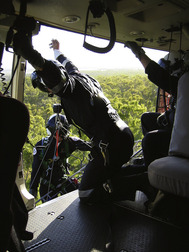CASE 45
 |
Incident
A 25-year-old male has fallen 3 metres (10 feet) from a hiking track in an isolated, mountainous and heavily forested national park. He is unable to walk due to a suspected lower limb fracture and is complaining of neck, abdominal and lower back pain. His only companion is uninjured and has notified emergency services via a satellite phone.
Relevant information
Aircraft: Rotary wing capable of winch rescue
Ground resources: Hiking companion on scene. Voluntary land ambulance and national parks personnel at nearest access road 2 km (1.2 mile) from scene
Retrieval options: General hospital 50 minutes by air
Other: Temperature 35°C (95°F). Wind at 3 km/h (2 mph). Local time 12:20 hours
Questions
45.1 Outline the possible options for patient access and egress in this situation.
45.2 What factors should be considered when formulating the plan?
45.3 A winch rescue is planned. Outline the key components in this process.
45.4 What common problems and rare emergencies associated with winch operations should the PHR team be aware of?
Discussion
45.1 Any combination of the following is possible. A brief overview is provided for each in the table below.
| Options for patient access and egress | |
|---|---|
| Patient access | Patient/team egress |
Winch-in A winch-in will allow at least one member of the PHR team to be with the patient as soon as possible. Additional medical and rescue equipment can also be winched in. In combination, this will facilitate early patient assessment and treatment. | Winch-out A winch-out will see the patient en route to the nearest medical facility relatively quickly. In addition, patient movement may be minimised when compared to a prolonged stretcher carry or road transfer over uneven terrain. |
Walk-in The PHR team and required equipment may be dropped at the nearest safe landing site and then (ideally with the assistance of ground resource personnel) proceed to the scene by foot. | Walk-out Following the winch-in, the aircraft may reposition to the nearest available safe landing site. The plan may then be to rendezvous with the PHR team and patient or return to base and allow the team and patient to proceed by road ambulance. |
Other Rarely, PHR team members or other personnel may access a scene via rappelling techniques (abseiling down a static line while controlling descent with a variable friction device) or directly from the aircraft skids to fixed ground-based structures. These techniques are not discussed further here. | Other A rescue strop (harness) is frequently used for uninjured persons requiring hoist rescue, particularly in the marine environment. This technique would not be appropriate in this setting and is not discussed further. An off-road vehicle may be available for team and patient transport to and from a rendezvous point with either the aircraft or road ambulance vehicles. Regional variation will dictate both availability and capability in this regard. |
45.2 The ultimate decision here is whether a winch rescue is appropriate. A risk–benefit analysis is required, often at a time when relevant factors are either not entirely clear or variable. The key to any dynamic mission planning in this setting is a shared understanding by the entire mission team (aviation and medical) of the factors requiring consideration. Pre-mission briefing and regular team training, operational exposure and debriefing will maximise the team’s ability to respond safely and effectively in such situations. Ultimately, the pilot is the mission commander and final decisions regarding any aircraft movement rest with them.
A non-exhaustive list of factors that should be considered includes:
Aviation
‘WINCHES’
• W – Weather and wind.
• Inclement weather and poor visibility clearly increases the aviation risk. In addition, extreme heat and minimal wind will increase the power requirements of a rotary-wing aircraft in the hover position.
• I – In and out (approach and exit).
• A flight path into and out of the hover/winch position should be clear of hazards.
• N – Night or day?
• Night or twilight winch operations increase the complexity and risk of such missions.
• C – Capacity (load) and endurance of aircraft.
• Rotary-wing aircraft will vary in terms of engine number and performance. The load capacity of any one aircraft will also vary between missions. Large numbers of personnel and equipment, high ambient temperatures, minimal wind speeds and high fuel requirements will significantly limit both the range (distance travelled) and endurance (engine time) of the aircraft for a given mission.
• In this case, there may be very little time on ground for the PHR team should a winch-in/winch-out plan be made.
• H – Hazards and height.
< div class='tao-gold-member'>
Only gold members can continue reading. Log In or Register to continue
Stay updated, free articles. Join our Telegram channel

Full access? Get Clinical Tree








